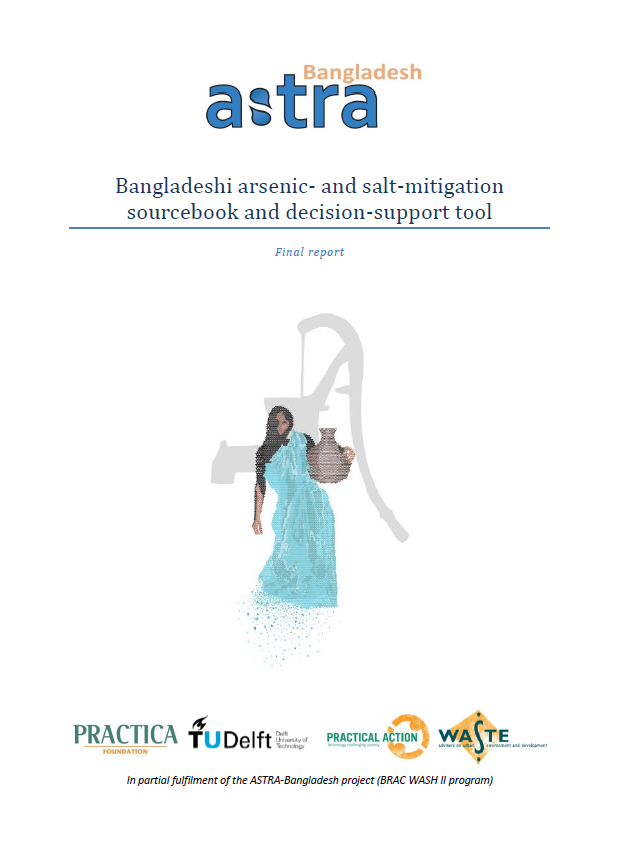🌿 COP 30 - Building a Greener Tomorrow
The 30th UN Climate Change Conference (COP 30) is taking place in Belém, Brazil. Stay informed about global climate actions, negotiations, and live sessions from 10 – 21 November 2025.
Get Updates
Bangladeshi arsenic and salt mitigation sourcebook and decision support tool

Files
Date
January, 2024Author(s)
- Dr.ir. Gábor SZÁNTÓ
- Dr.ir. Doris van HALEM
- Samuele OLIVERO, MSc
- Prof.dr.ir. Louis C. RIETVELD
- Alida PELGRIM-ADAMS, MSc
- Dipok Chandra ROY, MSc
- Jacqueline BARENDSE, MBA
- Valentin POST, MS
Abstract
This publication contains the detailed description of the ASTRA arsenic- and salt-mitigation tool developed in the framework of the BRAC WASH II programme. In essence, this work is a supporting compendium and tool for decision-makers, practictioners and education institutes. It’s main objective is to aim understanding and identification of potentially appropriate technological solutions to tackle the widespread arsenic and salinitiy problems in the water sources of Bangladesh. Confirm the currently available solutions, the work leans towards the removing or mitigating of arsenic and – where treatments are included – solutions that mainly concern disinfection and (in)filtration. The contained information draws on both Bangladeshi and international research and practical experience. The general mitigation strategy is explained as the identification of potentially appropriate water supply methods for implementation in Bangladesh. The identification process is based on a multidisciplinary assessment and matching of method functionality with the intended local context. This book contains both the critical reviews and practical information of all potentially applicable technical mitigation methods to aid decision-makers and engineers. In the first chapter of the publication, the growing water stress and its key drivers in Bangladesh are listed and detailed. This sourcebook section enables the proper understanding of mitigation methods through a range of critical reviews that can either treat or circumvent arsenic- or salt-contaminated sources. Three mitigation routes are outlined that include water supply or treatment methods. These mitigation options are to (i) target arsenic- or salt-free groundwater, (ii) treat arsenic- or salt-contaminated groundwater or (iii) disinfection of alternative, non-groundwater sources. Utilizing one or more of the identified mechanisms, 26 specific technological methods are identified as eligible for the Bangladeshi water sector context. Their in-depth descriptions are given in chapter 6 of this book. The descriptions of technical, institutional, ecological and socio-economic features are completed by eligibility matrices. The matrices demonstrate quality of functioning according to local- or project-specific criteria and allow users to assess performance of the method in the context of application. The description of the content of the decision-suport tool are coupled to the manual on how to use it and the related online version. Finally, a discussion is offered that tackles indirect considerations that Bangladeshi water experts could apply to further improve the sustainability of the local water sector. The chosen structure of this publication allows two distinctively different utilizations. Decision-makers and engineers may view potential approaches first before formulating specific strategies to mitigate the arsenic-related problems. As the compendium section is also possible to use without the more theoretical initial parts, especially field experts are hoped to benefit from the technology information sheets and matrices during multistakeholder processes of water projects.
Citation
No citation
Publisher
BRAC and IRC International Water and Sanitation Centre and funded by the Embassy of the Kingdom of the Netherlands (Bangladesh).
Rights Holder
BRAC and IRC International Water and Sanitation Centre and funded by the Embassy of the Kingdom of the Netherlands (Bangladesh).
URI
https://knowledgehub.pksf.org.bd/collections/azVKNWh6UW1ITS85ZkdEaXpXK3lSUT09
